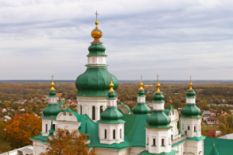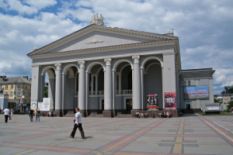Old Town of Lviv
Perhaps one of the most-visited and vast UNESCO heritage sites is the Old Town of Lviv. The historic city center was listed as a UNESCO World Heritage Site in 1998. According to the organization, 'In its urban fabric and its architecture, Lviv is an outstanding example of the fusion of the architectural and artistic traditions of eastern Europe with those of Italy and Germany.' UNESCO distinguishes three major areas of Old Town that host about two thousand cultural and natural landmarks. Naturally, it would take a separate list to name them all, so here are the most renowned ones.The High Castle, also called Vysokyi zamok or Zamkova hora, is the highest point in Lviv and one of the most popular tourist attractions. The hill hosts the ruins of the castle built way back in 1250 to protect the city during the Halych-Volhynia period. The High Castle's neighborhood, including the 18th-century churches, is included in the Heritage Sites as well. The heart of Lviv, Rynok Square, was founded by Casimir III during the 14th century when the city was granted the Magdeburg Law. Lviv Town Hall is among the most-visited landmarks on the site.
Naturally, Lviv churches with luxurious interior couldn't be omitted by UNESCO. Thus, the ensemble of the 1629 Church of Assumption, the 1630 Baroque Bernardine Monastery, the 1363 Armenian Cathedral, the 1493 Latin Metropolitan Cathedral with the famous Boim and Kampians' Chapels, the 1630 Jesuit Cathedral and the 1749 Dominican Church are all noted as exceptional by UNESCO.
The City Arsenal built in the 16th century and now hosting an armory museum is also included in the Lviv's heritage sites list. Another landmark that is a part of the former fortifications system is the 1556 Gunpowder Tower that stands in the heart of the city.
Finally, Saint George’s Cathedral also called Saint Yura Cathedral, was separately recognized by UNESCO. The baroque-rococo church designed by the famous Galician sculptor Johann Pinsel stands on the Saint Yurii Hill. It used to be the mother church of the Ukrainian Greek Catholic Church and still attracts believers nowadays.
Residence of Bukovinian and Dalmatian Metropolitans
 This UNESCO site is located in Chernivtsi, a city often called the Little Vienna for the rich Austro-Hungarian architectural heritage. Nowadays the luxurious building belongs to Chernivtsi National University and is its main campus site. However, historically it had been used as a residence of Bukovininian and Dalmatian Metropolitans. The construction of the residence began in 1864 and lasted for almost twenty years.
This UNESCO site is located in Chernivtsi, a city often called the Little Vienna for the rich Austro-Hungarian architectural heritage. Nowadays the luxurious building belongs to Chernivtsi National University and is its main campus site. However, historically it had been used as a residence of Bukovininian and Dalmatian Metropolitans. The construction of the residence began in 1864 and lasted for almost twenty years.
Thanks to the prolonged efforts, visitors can now enjoy the eclectic-styled building decorated with marble, crystals and gold. In 2011, UNESCO included the main building of Yurii Fedkovych Chernivtsi National University in the list of World Cultural Heritage for 'exhibiting an important interchange of human values', 'bearing a unique testimony to a cultural tradition' and 'being an outstanding example of an architectural ensemble'.
Wooden Churches of the Carpathian Region
Another architecturally outstanding landmark noted by UNESCO is a joint cluster of wooden churches located in the Ukrainian Carpathians. It's interesting to note that UNESCO uses Ukrainian word, Tserkva, to emphasize the cultural significance.The churches have a quite typical construction style of the region. For instance, the Church of the Synaxis of the Blessed Virgin Mary in Matkiv is built in the traditional Boyko style way back in 1838. The church of the Descent of the Holy Spirit in Rohatyn is quite unique even on the UNESCO list - it's the oldest existing wooden church in Ukraine built in 1598. The 1720 church of the Holy Trinity in Zhovkva is famous for its iconostasis that features about 50 works made by the famous icon painted Ivan Rutkovych at the beginning of the 18th century.
Other Ukrainian landmarks from this category on the World Heritage list include Church of Saint George in Drohobych, Church of the Descent of the Holy Spirit in Rohatyn, and Church of Our Lord’s Ascension in Yasynia.
Beech Forests of the Carpathians
 The incredibly vast beech forests of the Ukrainian Carpathians are so unique they are included in the UNESCO World Heritage Sites list as an 'outstanding example representing significant on-going ecological and biological processes in the evolution'. For an easier navigation, we can distinguish two zones noted by UNESCO - the Carpathian Biosphere Reserve and Uzhok National Nature Park.
The incredibly vast beech forests of the Ukrainian Carpathians are so unique they are included in the UNESCO World Heritage Sites list as an 'outstanding example representing significant on-going ecological and biological processes in the evolution'. For an easier navigation, we can distinguish two zones noted by UNESCO - the Carpathian Biosphere Reserve and Uzhok National Nature Park.
The Carpathian Biosphere Reserve takes up about 140 acres in the eastern region of Zakarpattia. Its territory is truly huge and includes the famous Valley of Daffodils that lures in numerous tourists each spring. Among the other attractions, the Reserve grasps find Trufanets, the highest natural waterfall in Transcarpathia; the 92-meters long Milky Stone cave; Teretyn mountain that offers breathtaking views on the Carpathians and nearby villages and much more.
Uzhok or Uzhanskyi National Nature Park is located in Velykyi Bereznyi district of Zakarpattia. The territory lies near the Polish and Slovakian borders. The park was included in the UNESCO list in 2007. Uzhanian Nature Park lures in hikers with breathtaking views of the mountains, waterfalls and rivers. Besides, the area is culturally significant, as it is populated by Lemkos ethnical group.
Kyiv-Pechersk Lavra
 The main Orthodox sanctuary in Ukraine, Kyiv-Pechersk Lavra, was founded by St. Anthony and St. Theodosy in the 11th century. The monastery quickly became a prominent spiritual center that gathered believers all over the country and far beyond its borders. Kyiv-Pechersk Lavra is listed in UNESCO heritage site as an ensemble: it includes unique churches, including the underground ones, built in the 11th-19th centuries, a complex of labyrinthine caves, as well as domestic and household buildings dated the 17th-19th centuries.
The main Orthodox sanctuary in Ukraine, Kyiv-Pechersk Lavra, was founded by St. Anthony and St. Theodosy in the 11th century. The monastery quickly became a prominent spiritual center that gathered believers all over the country and far beyond its borders. Kyiv-Pechersk Lavra is listed in UNESCO heritage site as an ensemble: it includes unique churches, including the underground ones, built in the 11th-19th centuries, a complex of labyrinthine caves, as well as domestic and household buildings dated the 17th-19th centuries.
The main monuments to explore on the site are the Dormition Cathedral, the Trinity Gate Church, the Great Bell Tower, the Church of All Saints, as well as the Refectory Church. Besides, the monastery also has defensive walls with towers and intricate cave complexes of St. Anthony and St. Theodosy that are connected to the overground churches.
Saint Sophia Cathedral
 One of the most-visited sites on the Ukrainian UNESCO Heritage list, the Saint Sophia Cathedral was named after the biggest Orthodox Christian cathedral of the time Hagia Sophia in Istanbul. Back in the 11th century, the 13-dome sanctuary was adjoined to Prince Yaroslav’s Palace and became a holy place of worship for all believers in Kyiv Rus. It was originally built to celebrate Prince Yaroslav's victory in protecting Kyiv from nomadic tribes. Nowadays, visitors can witness the original mosaics and frescoes, dating back to 1017–31.
One of the most-visited sites on the Ukrainian UNESCO Heritage list, the Saint Sophia Cathedral was named after the biggest Orthodox Christian cathedral of the time Hagia Sophia in Istanbul. Back in the 11th century, the 13-dome sanctuary was adjoined to Prince Yaroslav’s Palace and became a holy place of worship for all believers in Kyiv Rus. It was originally built to celebrate Prince Yaroslav's victory in protecting Kyiv from nomadic tribes. Nowadays, visitors can witness the original mosaics and frescoes, dating back to 1017–31.
It's interesting that each mosaic and fresco isn't simply randomly placed but has its assigned position according to Byzantine decorative scheme, which turns the church into a giant 3D symbol of the Orthodox world order. The 6-meter high Virgin Oranta is the most eye-catching composition in the cathedral. Having survived this long, this particular Oranta is now thought indestructible by Orthodox believers.
Apart from the cathedral itself, the 76-meter tall bell tower and Saint Sophia's crypt are also included in the UNESCO heritage site list. The latter hosts the remains of Yaroslav Mudryi, his son Vsevolod, and Prince Volodymyr Monomakh.
Photo sources: shutterstock.com, depositphotos.com, Serhii Krynytsia (Haidamac), Valerii Yatsyshyn / wikipedia.org.

















